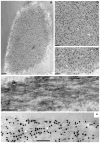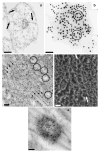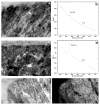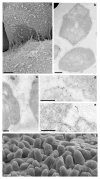Immunogold TEM of otoconin 90 and otolin - relevance to mineralization of otoconia, and pathogenesis of benign positional vertigo
- PMID: 22841569
- PMCID: PMC3587656
- DOI: 10.1016/j.heares.2012.07.003
Immunogold TEM of otoconin 90 and otolin - relevance to mineralization of otoconia, and pathogenesis of benign positional vertigo
Abstract
Implementation of the deep-etch technique enabled unprecedented definition of substructural elements of otoconia, including the fibrillar meshwork of the inner core with its globular attachments. Subsequently the effects of the principal soluble otoconial protein, otoconin 90, upon calcite crystal growth in vitro were determined, including an increased rate of nucleation, inhibition of growth kinetics and significant morphologic changes. The logical next step, ultrastructural localization of otoconin 90, by means of immunogold TEM in young mature mice, demonstrated a high density of gold particles in the inner core in spite of a relatively low level of mineralization. Here gold particles are typically arranged in oval patterns implying that otoconin 90 is attached to a scaffold consisting of the hexagonal fibrillar meshwork, characteristic of otolin. The level of mineralization is much higher in the outer cortex where mineralized fiber bundles are arranged parallel to the surface. Following decalcification, gold particles, as well as matrix fibrils, presumed to consist of a linear structural phenotype of otolin, are aligned in identical direction, suggesting that they serve as scaffold to guide mineralization mediated by otoconin 90. In the faceted tips, the level of mineralization is highest, even though the density of gold particles is relatively low, conceivably due to the displacement by the dense mineral phase. TEM shows that individual crystallites assemble into iso-oriented columns. Columns are arranged in parallel lamellae which convert into mineralized blocks for hierarchical assembly into the complex otoconial mosaic. Another set of experiments based on immunogold TEM in young mice demonstrates that the fibrils interconnecting otoconia consist of the short chain collagen otolin. By two years of age the superficial layer of mouse otoconia (corresponding to mid-life human) has become demineralized resulting in weakening or loss of anchoring of the fibrils interconnecting otoconia. Consequently, otoconia detached from each other may be released into the endolymphatic space by minor mechanical disturbances. In humans, benign positional vertigo (BPV) is believed to result from translocation of otoconia from the endolymphatic space into the semi-circular canals rendering their receptors susceptible to stimulation by gravity causing severe attacks of vertigo. The combinations of these observations in humans, together with the presented animal experiments, provide a tentative pathogenetic basis of the early stage of BPV.
Copyright © 2012 Elsevier B.V. All rights reserved.
Figures






Similar articles
-
Mammalian Otolin: a multimeric glycoprotein specific to the inner ear that interacts with otoconial matrix protein Otoconin-90 and Cerebellin-1.PLoS One. 2010 Sep 15;5(9):e12765. doi: 10.1371/journal.pone.0012765. PLoS One. 2010. PMID: 20856818 Free PMC article.
-
Gene targeting reveals the role of Oc90 as the essential organizer of the otoconial organic matrix.Dev Biol. 2007 Apr 15;304(2):508-24. doi: 10.1016/j.ydbio.2007.01.013. Epub 2007 Jan 12. Dev Biol. 2007. PMID: 17300776 Free PMC article.
-
In vitro calcite crystal morphology is modulated by otoconial proteins otolin-1 and otoconin-90.PLoS One. 2014 Apr 18;9(4):e95333. doi: 10.1371/journal.pone.0095333. eCollection 2014. PLoS One. 2014. PMID: 24748133 Free PMC article.
-
Mixing model systems: using zebrafish and mouse inner ear mutants and other organ systems to unravel the mystery of otoconial development.Brain Res. 2006 May 26;1091(1):58-74. doi: 10.1016/j.brainres.2006.01.074. Epub 2006 Mar 9. Brain Res. 2006. PMID: 16529728 Free PMC article. Review.
-
Otoconia in health and disease. A review.Ann Otol Rhinol Laryngol Suppl. 1984 Jul-Aug;112:17-24. doi: 10.1177/00034894840930s404. Ann Otol Rhinol Laryngol Suppl. 1984. PMID: 6431876 Review.
Cited by
-
Spatiotemporal differences in otoconial gene expression.Genesis. 2016 Dec;54(12):613-625. doi: 10.1002/dvg.22990. Epub 2016 Nov 12. Genesis. 2016. PMID: 27792272 Free PMC article.
-
Review of Post-embedding Immunogold Methods for the Study of Neuronal Structures.Front Neuroanat. 2021 Oct 14;15:763427. doi: 10.3389/fnana.2021.763427. eCollection 2021. Front Neuroanat. 2021. PMID: 34720893 Free PMC article. Review.
-
Climatic Variations as Indicators of Vitamin D Levels and Benign Paroxysmal Positional Vertigo.Cureus. 2021 Oct 15;13(10):e18811. doi: 10.7759/cureus.18811. eCollection 2021 Oct. Cureus. 2021. PMID: 34804669 Free PMC article.
-
Causes and treatment of idiopathic benign paroxysmal positional vertigo based on endocrinological and other metabolic factors.J Otol. 2020 Dec;15(4):155-160. doi: 10.1016/j.joto.2020.04.001. Epub 2020 Jun 1. J Otol. 2020. PMID: 33293917 Free PMC article. Review.
-
Feasibility and safety of repositioning maneuvers for posterior semicircular canal BPPV (benign paroxysmal positional vertigo) in elderly over 80 years of age.Eur Arch Otorhinolaryngol. 2025 Jul;282(7):3443-3447. doi: 10.1007/s00405-025-09234-x. Epub 2025 Jan 30. Eur Arch Otorhinolaryngol. 2025. PMID: 39885010
References
-
- Agrawal Y, Carey JP, la Santina CC, Schubert MC, Minor LB. Disorders of balance and vestibular function in US adults: data from the National Health and Nutrition Examination Survey, 2001–2004. Archives of Internal Medicine. 2009;169:938–944. - PubMed
-
- Anniko M, Ylikoski J, Wroblewski R. Microprobe analysis of human otoconia. Acta Otolaryngology. 1984;97:283–289. - PubMed
-
- Baloh RW, Honrubia V, Jacobson K. Benign positional vertigo: clinical and oculographic features in 240 cases. Neurology. 1987;37:371–378. - PubMed
-
- Campos A, Canizares FJ, Sanchez-Quevedo MC, Romero PJ. Otoconial degeneration in the aged utricle and saccule. Advances in Otorhinolaryngology. 1990;45:143–153. - PubMed
-
- Colfen H. Biomineralization: a crystal-clear view. Nature Materials. 2010;9:960–961. - PubMed
Publication types
MeSH terms
Substances
Grants and funding
LinkOut - more resources
Full Text Sources
Other Literature Sources
Medical
Molecular Biology Databases

